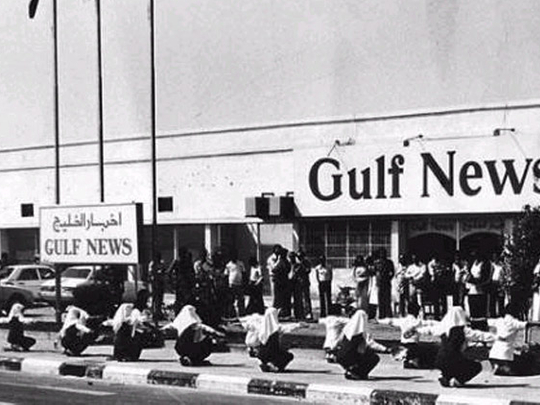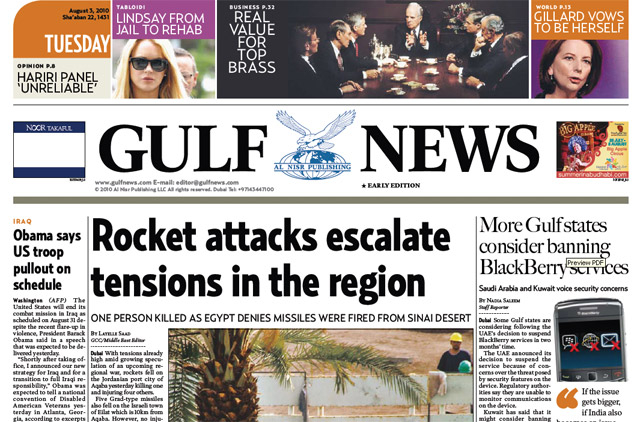
On September 30, 1978, a 16-page black-and-white tabloid newspaper was hand-delivered to homes and newsstands in Dubai sometime around mid-morning.
Dubai was a small town with a growing expatriate community that had limited access to international news. There was no international media in the region, satellite television or the internet.
The local media did not satiate the thirst for information, and the only way you could find out about the world outside was to go to some of the hotels that would pin the Reuters and Associated Press tickers on boards in their lobbies.
So when Gulf News reached homes that September morning with headlines that cautioned people about drinking and driving, and announced Pope John Paul's untimely death, it opened the floodgates of information.
The newspaper was founded by UAE businessman Abdullah Abulhoul and its offices were located on the Airport Road in Deira. Its first editor was Tim Edgar.
In those days the main function of the paper was to talk to the region's English-language readers about what was happening in the UAE as well as internationally, promising compelling and relevant content, commentary and entertainment and humour.
Dubai was slowly beginning to take shape at that point, with the opening of the World Trade Centre on Shaikh Zayed Road, reflecting a move forward for business in the emirate.
It was still a small community, and rumour was the main source of news. The government was starting to implement its developmental plans and people were eager to know what was happening all around.
Gulf News operated as a voice between the government and the people, talking to readers about what concerned them. Even in the early days with limited resources the paper strived to publish a variety of news.
Headlines ranged from the local to the global, such as the crackdown on illegal immigrants, to polio outbreak, to the news of the 1978 Nobel Peace Prize being awarded jointly to Egyptian President Anwar Sadat and Israeli Prime Minister Menachem Begin.
The paper also catered to softer interests by publishing pictures of ‘Dubai from the Sky', announcing the ‘Great British Supper Dance' at the Dubai Marine Hotel or Boogie Nights at Costain's where under-18s could organise and run their own disco.
The relaunch
When the paper first started rolling it had a circulation of 3,000 copies daily, six days a week. The format was changed from tabloid to broadsheet size on January 1, 1980 and publication became seven days a week.
In November 1984 three leading UAE businessmen purchased the company and formed Al Nisr Publishing.
The new directors, Obaid Humaid Al Tayer (managing director), Abdulla Hassan Al Rostamani (director) and Juma Al Majid (director), immediately injected a large sum of money into a new printing press and the entire paper was reshaped and replanned.
Since the death of Abdulla Hassan Al Rostamani in 2006, a family nominee has held his position on the board. The other directors remain.
Under the new management Gulf News was relaunched on December 10, 1985. During that year the paper built its new premises on Shaikh Zayed Road.
In 1985 Dubai took another step forward with the launch of Emirates airline. By then the government had also issued a decree for the Jebel Ali Free Zone and Dubai Duty Free was open for business.
The winds of change had started to blow through the sandy stretches of empty lots in mid-town Dubai and people were hungry for more.
The UAE was experiencing an awakening as growth spread from Dubai to Abu Dhabi and other emirates.
Francis Matthew, Business Editor at the time of the relaunch and now Editor-at-Large, says, "At the time of the relaunch Gulf News was selling about 3,000 copies. It was a miserable business."
"We put out 40,000 copies free from December 1985 to February 1986 in order to build the reading habit, and we made a lot of noise around that time about the paper."
"Slowly we converted the free copies to paid subscriptions (Dh1) and began the long haul of building the circulation through the trust of the readership to where we are now."
The paper's unwavering allegiance to its readers, its commitment to the community and the importance it gives to social responsibility have been the hallmark of how Gulf News operates.
"The newspaper got involved at the very beginning to address the community and bring some fun into life."
"We promoted arts, culture, music through sponsorship of events, started the Fun Drive in 1986, promoted major sports events and that's how we built a public awareness that we cared about people," says Matthew.
Gulf News has always given its readers a chance to discuss, comment upon and contribute to the content, and the many letters it receives today are testament to the very strong sense of loyalty that readers have for the paper.
Role in society
The late president of the UAE, Shaikh Zayed Bin Sultan Al Nahyan, placed a lot of importance on the role of the press. He wanted the press to play an active role in the development of the UAE and in realising the dreams of the nation.
Over the years Gulf News has helped build a strong civil society with committed citizens by channelling discussions from the private to the public domain. "It took a long time for society to accept the public discussion of difficult issues," says Matthew.
"So when we published reports on thievery in Satwa or about a bankrupt running away, it was not about creating a scandal. The newspaper worked in the public interest and our main aim was to make people aware and create a better society."
Gulf News has played an active part in spelling out the UAE's position in foreign policy. It has been part of building the public impression that the UAE is a tolerant country that believes in peace through negotiations.
"The mix of cultures in the UAE is polite and our community expects a polite and caring paper. We don't do aggressive and intrusive stories. We do stories in the public interest and that's what makes us strong," says Matthew.
Giving colour to news
One of the things differentiating Gulf News from other publications operating in the market has been constant innovation.
The paper printed the first colour news picture in the region in 1986 of a blue sky with a plume of white smoke. Gulf News was criticised at that point for playing with the gravity of black-and-white news, but in reality the publication was much ahead of its time.
It was printing colour at the same time the first UK newspaper, Today, printed colour, and while the latter did not get it right, Gulf News was a great success. The paper was the first in the Gulf with a tabloid leisure section, a family weekly magazine and a children's weekly magazine.
Gulf News was also the first with a separate tabloid classified section, the first with computerised page make-up in 1988, with the most advanced printing press in the Middle East, with separate classified sections (Properties and Freehold) and it was the first one to use re-cycled newsprint.
Growing with the UAE
The paper has constantly changed - both in design and content - to cater to a more sophisticated market and in doing so has mirrored the strides the UAE has made as a nation.
In the 1990s Dubai transformed itself into an economic powerhouse, becoming home to people from almost all over the world. In May 1998 the first phase of Dubai Airport's development was completed with the inauguration of the Shaikh Rashid Terminal.
The iconic Burj Al Arab opened its doors in December 1999; in 2000 and 2001 Dubai Internet City and Dubai Media City started functioning.
The next few years saw The Palm and The World take shape and development in other emirates such as Abu Dhabi and Ras Al Khaimah accelerated.
The economy galloped on as Dubai International Financial Centre started operations in 2004, and the same year saw the beginnings of the Burj Dubai. Economic growth of the country and the growth of the paper have evolved together.
The paper solidified its position in the region, changed its style and increased its coverage to stay many steps ahead of the competition.
On November 30, 1995, the width of the broadsheet pages was reduced by four centimetres to create the new international size of 38 centimetres. The paper made use of the most advanced printing press in the Middle East.
On June 21, 2003 it was redesigned once more, taking advantage of improved colour press quality and capacity. For better local coverage, the paper opened bureaux in the other emirates, GCC countries and the subcontinent, and from 1997 onwards started publishing weekly and monthly magazines.
The first web edition of Gulf News was launched on September 1, 1996, to cater to a whole new generation of digital natives. For this generation of technology-savvy young people, the Gulf News website (with more than a million hits a day) is the medium of choice for news consumption.
Today, despite the newspaper's leading position, Abdul Hamid Ahmad, Editor-in-Chief/Executive Director Publications, Gulf News says the paper has to keep evolving and challenging itself as competition becomes stronger.
Steady circulation
With a stable management at the helm who understand the needs of the media business and by practising good governance, Gulf News today is not just a leading local paper, but has made its mark at the global level.
It is a voice to the English-speaking world about what the Gulf thinks, and with the help of independent thinkers and intellectuals it brings to this world a live, varied and rich debate about social issues, environmental concerns and regional politics.
According to the Print Readership Survey conducted by global research company Ipsos Stat in the UAE in 2009, Gulf News is the English newspaper with the highest reach in the UAE.
The Classifieds and Tabloid sections of Gulf News also have a higher reach compared to other English newspapers. Where circulation is concerned, Gulf News enrolled for the BPA audit in January 2006 and according to latest audit reports (October 2007-March 2008), the qualified circulation figures stand at 115,836.
If a strong editorial has been one end of the spectrum, the other end has been an effective marketing team who made sure the revenue trickled in through good advertising and promotions.
Duleep George, Executive Director Marketing and Sales of Gulf News, says, "You spend a lot of time, money and energy on innovation, but competition makes it very difficult to sustain things. We treated the newspaper like any other Fast Moving Consumer Good (FMCG) and we used promotions to get the product going. But at the end you might have a good product, but you have to make your money out of advertising."
The Gulf News Classifieds section, ‘the busiest market place in the Gulf' took off well and helped the paper finance other projects. Today the classified products reach all occupation groups in the UAE.
For Gulf News it has so far been a story of change, innovation, evolution and pioneering journalism in the Middle East. It has been a tale of many firsts, milestones, and one that reflects the hard work of many individuals, and reflects in every page the growth of a city and a nation.
His Highness Shaikh Mohammad Bin Rashid Al Maktoum, Vice President and Prime Minister of the UAE and Ruler of Dubai once said, "We have succeeded because we have always believed that tomorrow is a new day, that yesterday's achievements are in the past and that history will record what we achieve in the future, not what we have achieved in the past."
These words may have been meant for Dubai, but they ring true for Gulf News.



